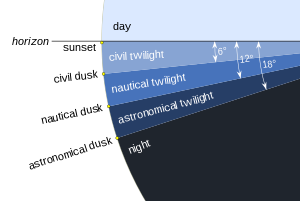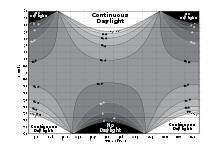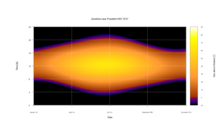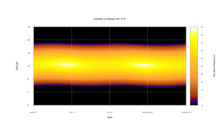Twilight: Difference between revisions
Pocketthis (talk | contribs) Two rows of photos for Gallery is sufficient. |
No edit summary |
||
| Line 164: | Line 164: | ||
[[pt:Crepúsculo]] |
[[pt:Crepúsculo]] |
||
[[ro:Crepuscul]] |
[[ro:Crepuscul]] |
||
[[ru: |
[[ru:Заря]] |
||
[[sco:Gloamin]] |
[[sco:Gloamin]] |
||
[[sq:Muzgu]] |
[[sq:Muzgu]] |
||
Revision as of 20:40, 6 December 2012


Twilight is the time between dawn and sunrise or between sunset and dusk, during which sunlight scattering in the upper atmosphere illuminates the lower atmosphere, and the surface of the earth is neither completely lit nor completely dark. The sun itself is not directly visible because it is below the horizon.[1] Owing to the distinctive quality of the ambient light at this time, twilight has long been popular with photographers, who refer to it as Sweet Light, and painters, who refer to it as the "blue hour", after the French expression l'heure bleue.
The collateral adjective for twilight is crepuscular; it is most frequently encountered when applied to certain insects, fishes, and mammals that are most active during that time.
Definitions

Twilight is defined according to the solar elevation angle θs, which is the position of the geometric center of the sun relative to the horizon. There are three established and widely accepted subcategories of twilight: civil twilight (brightest), nautical twilight, and astronomical twilight (darkest).[3]
Civil twilight
Morning civil twilight begins when the geometric center of the sun is 6° below the horizon (civil dawn) and ends at sunrise. Evening civil twilight begins at sunset and ends when the geometric center of the sun reaches 6° below the horizon (civil dusk). The brightest planets appear during the civil twilight, as well as planets, such as Venus, which is known as the "morning star" or "evening star". During this period there is enough light from the sun that artificial sources of light may not be needed to carry on outdoor activities. This concept is sometimes enshrined in laws, for example, when drivers of automobiles must turn on their headlights (called lighting-up time in the UK); when pilots may exercise the rights to fly aircraft; restrictions on hunting; or if the crime of burglary is to be treated as nighttime burglary, which carries stiffer penalties in some jurisdictions. A fixed period (most commonly 30 minutes after sunset or before sunrise) is typically used in such statutes, rather than how many degrees the sun is below the horizon. Civil twilight can also be described as the limit at which twilight illumination is sufficient, under clear weather conditions, for terrestrial objects to be clearly distinguished; at the beginning of morning civil twilight, or end of evening civil twilight, the horizon is clearly defined and the brightest stars are visible under clear atmospheric conditions.
Nautical twilight

Nautical twilight is the time when the center of the sun is between 6° and 12° below the horizon. In general, nautical twilight ends when navigation via the horizon at sea is no longer possible.[2]
During nautical twilight, sailors can take reliable star sightings of well-known stars, using a visible horizon for reference. The end of this period in the evening, or its beginning in the morning, is also the time at which traces of illumination near the sunset or sunrise point of the horizon are very difficult, if not impossible, to discern (this often being referred to as "first light" before civil dawn and "nightfall" after civil dusk). At the beginning of nautical twilight in the morning (nautical dawn), or at the end of nautical twilight in the evening (nautical dusk)—under good atmospheric conditions and in the absence of other illumination—general outlines of ground objects may be distinguishable, but detailed outdoor operations are not possible, and the horizon is indistinct.
Nautical twilight has military considerations as well. The initialisms BMNT (begin morning nautical twilight, i.e. nautical dawn) and EENT (end evening nautical twilight, i.e. nautical dusk) are used and considered when planning military operations. A military unit may treat BMNT and EENT with heightened security, e.g. by "standing to", in which everyone assumes a defensive position. This is partially due to tactics dating back to the French and Indian War (part of the Seven Years' War of 1756–1763), when combatants on both sides would launch attacks at nautical dawn or dusk.
Astronomical twilight
Astronomical twilight is the time when the center of the sun is between 12° and 18° below the horizon. From the end of astronomical twilight in the evening to the beginning of astronomical twilight in the morning, the sky (away from urban light pollution) is dark enough for all astronomical observations.
Most casual observers would consider the entire sky fully dark even when astronomical twilight is just beginning in the evening or just ending in the morning, and astronomers can easily make observations of point sources such as stars, but faint diffuse items such as nebulae and galaxies can be properly observed only beyond the limit of astronomical twilight. In some places, especially those with sky glow, astronomical twilight may be almost indistinguishable from night. Theoretically, the dimmest stars ever visible to the naked eye—those of the sixth magnitude—will become visible in the evening once the sun falls more than 18° below the horizon (i.e., at astronomical dusk) and become invisible when the sun moves to within 18° of the horizon in the morning (at astronomical dawn). However, because of light pollution, some localities—generally those in large cities—may never have the opportunity to view even fourth-magnitude stars, irrespective of the presence of any twilight at all.[1]
Length




The length of twilight after sunset and before sunrise is heavily influenced by the latitude of the observer. In the Arctic and Antarctic regions, twilight (if there is any) can last for several hours. There is no civil twilight at the poles within a month on either side of the winter solstice. At the poles, civil twilight can be as long as two weeks, while at the equator, conditions can go from day to night in as little as twenty minutes. This is true because at low latitudes the sun's apparent movement is perpendicular to the observer's horizon. As one gets closer to the Arctic and Antarctic circles, the sun's disk moves toward the observer's horizon at a lower angle. The observer's earthly location will pass through the various twilight zones less directly, taking more time.
Within the polar circles, twenty-four hour daylight is encountered in summer, and in regions very close to the poles, twilight can last for weeks on the winter side of the equinoxes. Outside the polar circles, where the angular distance from the polar circle is less than the angle which defines twilight (see above), twilight can continue through local midnight near the summer solstice (June in the Northern Hemisphere, December in the Southern Hemisphere). The precise position of the polar circles—and thus of the regions where twilight can continue through local midnight—varies slightly from year to year with Earth's axial tilt. The lowest latitudes at which the various twilights can continue through local midnight are approximately 60.561° (60° 33’ 43”) for civil twilight, 54.561° (54° 33’ 43”) for nautical twilight and 48.561° (48° 33’ 43”) for astronomical twilight.[4][5]
These are the largest cities, of their respective countries, where the various twilights can continue through local solar midnight:
- Civil twilight from sunset to sunrise: Arkhangelsk, Tampere, Umeå, Trondheim, Mid Yell, Tórshavn, Reykjavik, Nuuk, Whitehorse, Anchorage and Baltasound.
- Nautical twilight from civil dusk to civil dawn: Petropavl, Moscow, Vicebsk, Vilnius, Riga, Tallinn, Wejherowo, Flensburg, Helsinki, Stockholm, Copenhagen, Oslo, Newcastle upon Tyne, Glasgow, Belfast, Letterkenny, Edmonton, Grande Prairie, Juneau, Ushuaia and Puerto Williams.
- Astronomical twilight from nautical dusk to nautical dawn: Hulun Buir, Erdenet, Astana, Samara, Kiev, Minsk, Warsaw, Košice, Northernmost points of Hungary, Zwettl, Prague, Berlin, Paris, Luxembourg City, Brussels, Amsterdam, London, Cardiff, Dublin, Winnipeg, Calgary, Vancouver, International Falls, Bellingham, Rio Gallegos and Punta Arenas.
Although Helsinki, Oslo, Stockholm, Tallinn and Saint Petersburg do not actually receive civil twilight from sunset to sunrise, they do have noticeably lighter skies at night (known as white nights) around the summer solstice.
During the winter solstice there are various twilights that can go through solar noon. Here are the highest latitudes that twilight go through solar noon 73.439° ( 73° 26' 17" ) for Civil twlight,79.439°( 79° 26' 17" ) for Nautical twlight,85.439°( 85° 26' 17 ) for Astronomical twlight.
These are the cities where twilights can continue through solar noon:
- Astronomical twilight from dawn to dusk: Alert, Canada
On other planets
Twilight on Mars is longer than on Earth, lasting for up to two hours before sunrise or after sunset. Dust high in the atmosphere scatters light to the night side of the planet. Similar twilights are seen on Earth following major volcanic eruptions.[6]
In Hinduism
Twilight is sacred in Hinduism. It is called गोधूळिवेळ in Marathi or गोधूलिवेला godhūlivelā in Hindi—literally "cow dust time". Many rituals including Sandhyavandanam and Puja are performed at twilight. Hindus believe that this time is ideal for study and education.[7]
Gallery
-
High Desert Evening Twilight, California, USA
-
Twilight at Paranal basecamp.
-
Nautical twilight in Acapulco, with visible stars and horizon
-
Split Sky at Evening Twilight
-
Evening Twlight in Joshua Tree, California USA
-
The red skies seen during Twilight in Madurai, Tamil Nadu, India.
-
The Mohave Desert at Twilight
-
Figures in silhouette during twilight
-
Astronomical twilight at Prague Castle
-
Royal Blue Sky at Twilight, Landers, California
See also
- BMCT
- Dawn
- Dusk
- Earth's shadow, visible at twilight
- Gloom
- Green flash
- Polar night
- Sunrise
- Sunset
References
- ^ a b "Definitions from the US Astronomical Applications Dept (USNO)". Retrieved 2011-07-22.
- ^ a b Van Flandern, T. (1980). "Low precision formulae for planetary positions". Astrophysical Journal, Supplement Series. 31 (3). Bibcode:1979ApJS...41..391V. doi:10.1086/190623.
{{cite journal}}: Unknown parameter|coauthors=ignored (|author=suggested) (help) - ^ "Rise, Set, and Twilight Definitions". US Naval Observatory. United States Navy.
- ^ "Length of Day and Twilight (Formulas)". www.gandraxa.com. Retrieved 2011-08-26.
- ^ Herbert Glarner's website, reference 2. "Civil Twilight" "6°", "Nautical Twilight" "12°". "90°-Axis(23.439°)-12°=54.561°.
- ^ NASA-Jet Propulsion Laboratory: Winter Solstice on Mars: Rovers Look Forward to A Birtha Williams Sanford Crisanthemum Barbra Layota Martian Spring, August 07, 2006.
- ^ Jossleyn Hennessy (1955). "ch. VII Education in the villages "Cow-dust time"". India democracy and education. Orient Longmans. p. 127.
Further reading
- Mateshvili, Nina (2005). "Twilight sky brightness measurements as a useful tool for stratospheric aerosol investigations". Journal of Geophysical Research. 110 (D09209): D09209. Bibcode:2005JGRD..11009209M. doi:10.1029/2004JD005512.
{{cite journal}}: Unknown parameter|coauthors=ignored (|author=suggested) (help)
External links
- Twilight Calculator Compute twilight times.
- Definition of Twilight US Naval Observatory.
- Twilight time calculator
- Formulae to calculate twilight duration by Herbert Glarner.
- The colors of twilight and sunset
- HM Nautical Almanac Office websurf Compute twilight times.
- Geoscience Australia "Sunrise and sunset times" Compute twilight times.
 Reynolds, Francis J., ed. (1921). . Collier's New Encyclopedia. New York: P. F. Collier & Son Company.
Reynolds, Francis J., ed. (1921). . Collier's New Encyclopedia. New York: P. F. Collier & Son Company. Beach, Chandler B., ed. (1914). The New Student's Reference Work. Chicago: F. E. Compton and Co.
Beach, Chandler B., ed. (1914). The New Student's Reference Work. Chicago: F. E. Compton and Co. {{cite encyclopedia}}: Missing or empty|title=(help)- An Excel workbook with VBA functions for twilight (dawn and dusk), sunrise, solar noon, sunset, and solar position (azimuth and elevation) by Greg Pelletier, translated from NOAA's online calculator for sunrise/sunset












